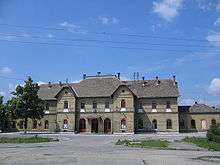Ferenc Pfaff
Ferenc Pfaff (born as Franz Pfaff, Mohács, 19 November 1851 – Budapest, 21 August 1913) was a Hungarian architect and academic.
Ferenc Pfaff | |
|---|---|
| Born | Franz Pfaff 19 November 1851 |
| Died | 21 August 1913 |
| Nationality | Hungarian |
| Alma mater | Technical University of Budapest |
| Occupation | Architect |
Career

Pfaff received his degree in 1880 after studying under Imre Steindl at the József Nádor Technical University in Budapest. Early in his career, he designed a number of smaller buildings, among which is the Roman Catholic church at Svábhegy.
However, he is best known for his career as an architect with the Hungarian Railways. Joining in 1887, he later became director of building works right across the Hungarian lands within the Austro-Hungarian Empire. In the following two decades he would design some 20 large, and numerous smaller railway stations, mainly in the Renaissance eclectic style. These buildings were often modest but notable for their fine sense of proportion and scale. He also redesigned a number of existing stations, notably in Croatia (Zagreb and Rijeka)[1] and in Hungary (Győr, Kassa and Miskolc).
Railway stations

.jpg)

- Arad
- Celldömölk
- Chop
- Debrecen
- Eszék (Osijek)
- Füzesabony, 1893
- Gyimesbükk (Ghimeș-Făget)
- Győr (remodelling)
- Kaposvár
- Karlovac
- Kassa (remodelling)
- Kolozsvár (Cluj-Napoca)
- Lipótvár (Leopoldov)
- Miskolc Gömöri railway station, 1899
- Miskolc Tiszai railway station, 1901 (remodelled)
- Nagykároly (Carei)
- Pécs, (1900)
- Pozsony (Bratislava), 1905
- Fiume (Rijeka), 1890
- Szatmárnémeti (Satu Mare), 1899
- Szeged, 1902 – restored in 2006 according to his original plans
- Temesvár (Timișoara), 1897
- Versec (Vršac)
- Zagreb Glavni railway station
- Zsombolya (Jimbolia)
Other buildings
- Szeged, MAV Directorship, 1894
- Budapest, Transport Museum, 1896
- Budapest, Svabhegyi Roman Catholic church, 1886
- Budapest, Stefania Palace, home to 1885 national art exhibition, then until 1945 City Museum
- Budapest, Exhibition hall
References
- Damjanovic, Dragan. "In the Shadow of Budapest (and Vienna) – Architecture and Urban Development of Zagreb in the Late 19th and Early 20th Centuries. // Zeitschrift für Ostmitteleuropa-Forschung / Journal of East Central European Studies. 67 (2018) , 4; 522–551". Zeitschrift für Ostmitteleuropa-Forschung / Journal of East Central European Studies.